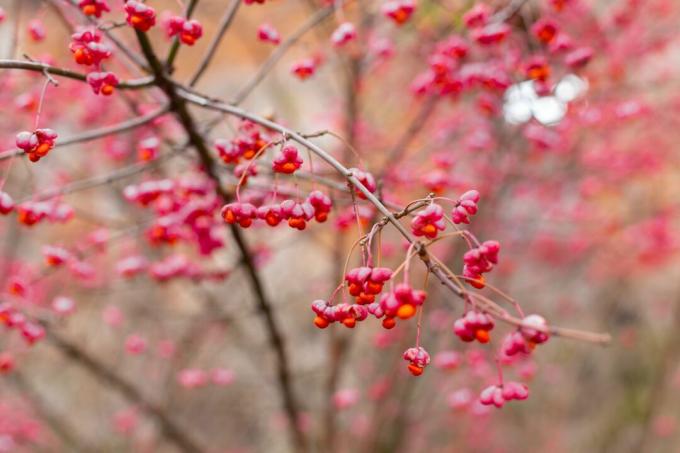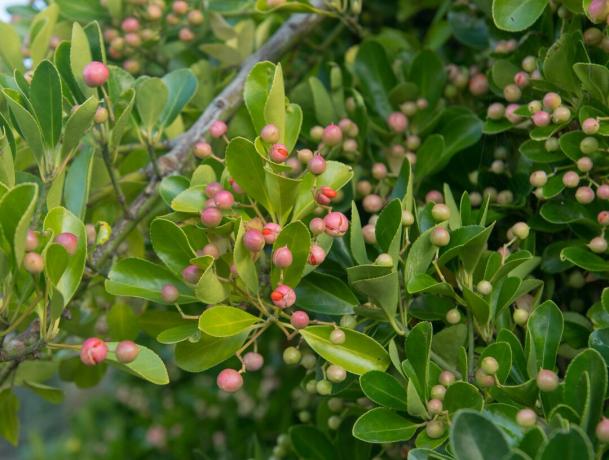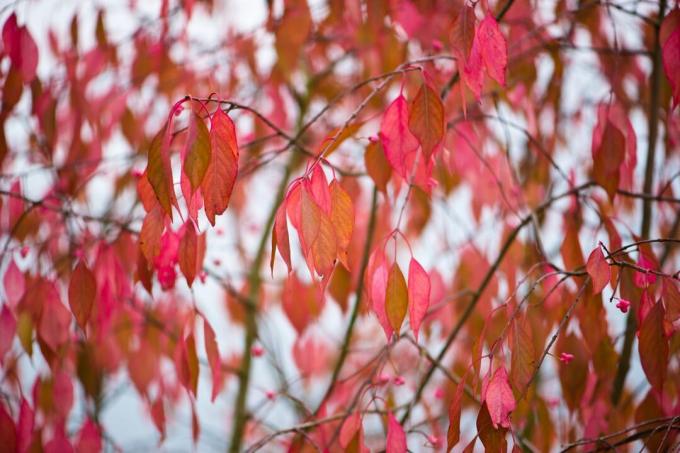We clarify how the spindle bush is planted and cared for correctly and whether it is poisonous. We also answer the question of whether the spindle shrub is hardy.

The spindle (euonymus) is a versatile plant for the garden. It provides privacy, facade greening and true color explosions. It also impresses with its robustness. In the past, a wide variety of everyday objects such as knitting needles or spindles were made from the resistant wood of the shrubs, which gave the spindle tree its name.
contents
- Spindle shrub: origin and properties
- Is the spindle tree poisonous?
-
Popular spindle shrub species
- Japanese Spindle (Euonymus japonicus)
- Creeping Spindle or Climbing Spindle (Euonymus fortunei)
- Spindle (Euonymus europaeus)
- Broad-leaved euonymus (Euonymus latifolius)
- Wing Spindle (Euonymus alatus)
- Spindle tree (Euonymus planipes)
- Plant spindle bush
-
Cultivate spindle bush
- Cut spindle bush
- Fertilize spindle bush
- Propagate Spindle Bush
- Spindle bush overwinter
- Spindle bush loses leaves: what to do?
Spindle shrub: origin and properties
Spindle shrubs are found throughout the Northern Hemisphere, mostly in East Asia. But there are also native species here in Europe, which are better known under the synonym spindle tree. The strikingly colorful four-fold fruits give the plant its name, the pink capsules with the orange fruiting bodies probably reminded people of the headgear of a cardinal. Depending on the species, the color of the capsule can also be more brown or gray. As its second name spindle shrub suggests, the growth form is shrubby or at most comparable to that of small trees. Spindle shrubs reach a maximum height of five meters. Some of them even only grow creeping or even climbing. The shrubs are densely branched and form a spreading crown. Many species can also be recognized by their square stems. Whether they are evergreen or deciduous differs by species. While the evergreen species are often tipped with golden or white variegated leaves come up, deciduous spindle shrubs turn all red in autumn.

Is the spindle tree poisonous?
All parts of the spindle tree are poisonous. The fruits in particular contain harmful glycosides and alkaloids. When consumed, this leads to vomiting and diarrhea and, if the dose is too high, can even lead to convulsions, collapse and even death. The symptoms of poisoning appear, however, at the earliest twelve hours after consumption.
The toxic effect is not only limited to us humans, but also to many animal species, such as horses or sheep. Only songbirds seem to be unaffected by the spindle shrub, because robin, magpies and thrushes see the bright fruits as a welcome food source in winter.
Popular spindle shrub species
Around 170 spindle shrub species are currently known. Most of them are from Southeast Asia, some even from the Himalayan region. Three species are native to Central Europe, which are also known as spindle trees and shed their leaves in autumn.
Japanese Spindle (Euonymus japonicus)
This species, which originates from Asia, is evergreen and can theoretically reach several meters in height. However, since the Japanese spindle tree is not hardy, it must be kept in a bucket or pot, where it stays a little smaller. The shrub has approximately 5 cm large leaves in a wide variety of colors, depending on the variety.
- 'Mareike': The golden-yellow leaf edge of this variety forms a beautiful contrast to the deep green leaf interior.
- 'Microphylla Variegata': The variety is characterized by small, about 3 cm large leaves with a white edge.
- 'Grey Beauty': This variety has green, gray and white variegated foliage.

Creeping Spindle or Climbing Spindle (Euonymus fortunei)
The evergreen spindle trees also include the creeping spindle. As the name already suggests, it does not grow upright, but creeping or climbing and is therefore an ideal ground cover in beds or a pretty green facade. Due to the low maintenance requirements, this species is often used for grave plantings or small hedges. Even if the creeping spindle is not native to Europe, it is hardy to around -20 °C.
- 'Emerald Gold': The popular variety has golden-yellow variegated leaves.
- ‘Coloratus’: The leaves, which are between 3 and 7 cm in size, are dark green and turn bright red in autumn and winter.
- 'Harlequin': The 'Harlequin' variety is striking with its almost white shoot tips and lightly speckled leaves.
Spindle (Euonymus europaeus)
The spindle tree, also known as the spindle tree, is the most common native species of spindle tree. The shrub grows densely branched and upright. In autumn its leaves turn a deep red. After they have fallen, the intensely colored fruits adorn the bush throughout the gray winter.
Broad-leaved euonymus (Euonymus latifolius)
Very similar to the common euonymus, the broad-leaved euonymus is primarily characterized by its broader leaves. The species is native, but its natural occurrence is limited to the Alps and the foothills of the Alps, which is why it is also known as the foothills of the Alps.
Wing Spindle (Euonymus alatus)
The winged spindle shrub is native to Japan and China and is hardy. Due to its intense autumn colors, the deciduous plant is also known as the burning bush. The shrub grows about 2 to 3 m high and just as wide. The cork ridges on the shoots, which come to light especially in winter, are striking.

Large-fruited euonymus (Euonymus planipes)
The plant, also known as the flat-stemmed spindle shrub, originally comes from Asia. It reaches heights of between 3 and 5 m and is often planted as an ornamental shrub in this country. Its winter buds are comparatively large, pointed, and strikingly purple.
Plant spindle bush
A spindle bush in your own garden is definitely something to look at: for example, a winged spindle bush standing alone as a Eye-catcher, a common or broad-leaved euonymus in a wild hedge or the creeping spindle as groundcover.
As far as its location is concerned, the plant is not that demanding, because it is extremely robust. In nature, spindle bushes are often found at the edges of forests, where it can be bright but sometimes shady. A sunny to semi-shady location is just the right thing. The shrubs are quite competitive when it comes to their roots and are not bothered by strong neighbors and their root pressure.
The soil should generally be rather fresh, nutritious and neutral, but the common and broad-leaved euonymus prefer it rather dry and slightly chalky. Both species also like damp soil, but they grow faster and more uncontrolled there.

Cultivate spindle bush
Spindle shrubs have made a name for themselves as easy-care shrubs. Their care is therefore very uncomplicated. Planted specimens actually only need to be watered at the beginning. Once established, they develop extensive root systems and are self-sufficient. Only in dry summers does a portion of water become necessary when the leaves begin to droop. Of course, potted spindles need to be watered because their roots cannot spread. You should water them regularly so that the root ball does not dry out. However, allow the soil above ground to dry out.
Cut spindle bush
Spindle bushes generally do not need to be pruned, as they develop a beautifully shaped crown by themselves. For evergreen species that are kept as a hedge or ground cover, you can simply put on the secateurs. The plants are very tolerant of pruning. Just be sure to prune your shrubs in early spring or late fall to avoid disturbing nesting birds. A frost-free and cloudy day in early spring or late autumn is ideal for pruning. In this way, the cuts are not strained and birds and other animals are not disturbed when nesting. Of course, you can also carry out minor interventions over the summer.
Fertilize spindle bush
If your spindle bush grows in humus-rich and nutrient-rich soil, no fertilization is necessary. Only on very poor locations is it worth adding a load of compost or our Plantura organic universal fertilizer incorporate into the soil around the plant. Plants kept in tubs should also be supplied with fresh nutrients in this way.
Propagate Spindle Bush
You can easily propagate spindle shrubs from cuttings. In the spring, cut a shoot with about three to four pairs of leaves and remove the bottom. Now put the cutting about a third into the soil and keep it moist. After some time the cutting will develop its own roots.
Spindle bush overwinter
Native spindle shrubs are hardy, as is the popular creeping spindle. However, the Japanese spindle shrub only withstands temperatures down to -5 °C and should therefore be protected during the cold season. Overwinter the evergreen shrub somewhere with temperatures between 6 and 10 °C. The winter quarters do not need to be overly bright, but should have a natural light source - if not, a plant lamp can help. During the winter, the plant needs little water, so the substrate is only slightly damp. Fertilizer should not be used in the winter quarters.

Spindle bush loses leaves: what to do?
There can be a number of reasons for leaf loss. It is often either too wet, which leads to root rot, or too dry. You can change this by changing your watering behavior or by draining the soil. An incorrect pH value can also be the cause. If the soil is too acidic, the spindle bush does not feel well. In this case, a portion of lime helps to increase the pH value.
